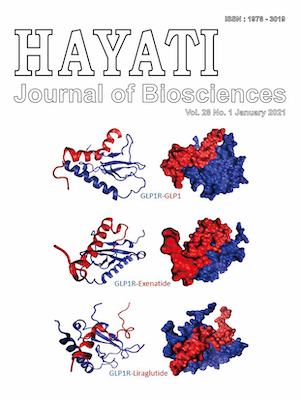Structure Identification and Quality Assessment of Laccase (Lac InaCC) from Neurospora crassa by Using a Structure Prediction
Abstract
Laccases are multi-copper oxidase enzyme, developed for being applied widely. The laccase gene in this study was isolated from local isolates of Neurospora crassa (LAC inaCC). The structure of this enzyme has not been known and there is no laccase structure of Neurospora crassa based on protein structure development in database. Here, we aimed to analyze the characteristics of the sequence and prediction structure, the structure quality after refinement through the molecular dynamics (MD) simulation method. LAC inaCC has been identified with typical sequence motifs (HWH, HSH, HXXH) which played role in copper-binding on 274(HWH)G-DG-T-CP on CBL-1, 314GT-WY(HSH)FS-QYG-G on CBL-2, and 607HPIHL on CBL-3. The four copper atoms have an important role in the catalytic activity. LAC inaCC is a multi-subunit enzyme consisted of three functional domains with structural motifs of Greek-key β barrel which is typical structure motif. Refinement in the prediction structure through the MD simulation showed that this method was proven to be able to improve the structure quality. The increase on the most favoured area on Ramachandran plot, clashcore percentile score, and molprobity score showed that the laccase structure headed to conformation change, to be more stable conformation with better resolution compared to earlier prediction structure.
Downloads
HAYATI J Biosci is an open access journal and the article's license is CC-BY-NC. This license lets others distribute, remix, tweak, and build upon author's work, as long as they credit the original creation. Authors retain copyright and grant the journal/publisher non exclusive publishing rights with the work simultaneously licensed under a https://creativecommons.org/


















.png) IPB University
IPB University Department of Biology
Department of Biology The Indonesian Biological Society
The Indonesian Biological Society 

